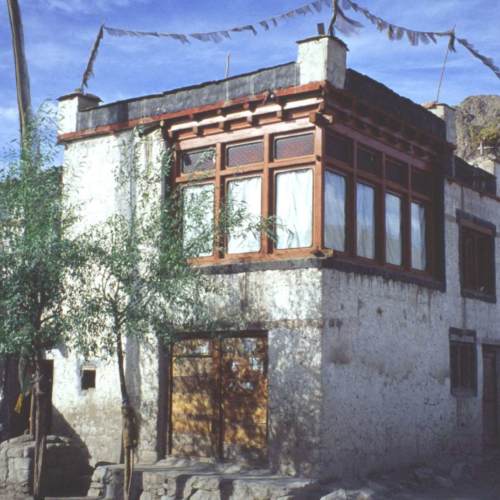Development of an Anthropological Pre-Design Study (APD Study) in Ladakh, North India
Teil 2 der Dissertation
Projektleitung: DI Andrea Rieger-Jandl
Partner: Institut für Kultur- und Sozialanthropologie, Universität Wien; Ladakh Ecological Development Group (LEDeG); Ladakh Environment and Health Organization (LEHO)
Projektform: Dissertation, Feldforschung, Publikation
Publikation: Rieger-Jandl, Andrea, 2005: Living Culture in the Himalayas. Anthropological Guidelines for Building in Developing Countries, Facultas Verlag, Wien, 263 Seiten
Laufzeit: 2000 – 2002
Ziel dieses Forschungsprojektes war die Entwicklung einer neuen methodischen Herangehensweise zur Erhebung von Planungsvoraussetzungen. Erhebungsmethoden wie Fragebögen, narrative oder strukturierte Interviews sowie teilnehmende Beobachtung wurden in erster Linie der Disziplin der Anthropologie entliehen und für Forschungszwecke in der Architektur adaptiert. Die im Zuge des Forschungsprojekts neu entwickelte Methode einer APD-Study (Anthropological Pre-Design-Study) sollte dazu beitragen, näher auf die Bedürfnisse und Erwartungen zukünftiger NutzerInnen bei Bauprojekten in Entwicklungsländern einzugehen.
Mit Hilfe anthropologischer Feldforschungsmethodiken (Umfragen, strukturierte- und halbstrukturierte Interviews, teilnehmende Beobachtung) wurden folgende Untersuchungen angestellt:
- Erhebung statistischer Daten
- Vergleich zwischen der vorherigen Wohnsituation in den Dörfern und der Wohnsituation in der Stadt
- Zukünftige Erwartungen, Wünsche und Vorstellungen betreffend die Wohnsituation
Die neue Methode wurde in Form einer anthropologischen Feldstudie in Ladakh/N-Indien erstmals implementiert. Überlokale Einflüsse haben in Ladakh in den vergangenen 30-40 Jahren zu extrem raschen sozialen, wirtschaftlichen und kulturellen Veränderungsprozessen geführt, die sich dementsprechend auf die Architektur und die Siedlungstätigkeit auswirken. Durch die Implementierung einer APD-Studie wurde eine Fülle von Daten gesammelt, deren Evaluierung einen umfassenden Überblick über die herrschenden Planungsvoraussetzungen vermittelt und eine Reihe von Anhaltspunkten für die Konzeption und Planungsarbeit weiterer Projekte liefern kann. Dadurch sollte ein befriedigerendes Ergebnis für die zukünftigen NutzerInnen von Siedlungsprojekten gesichert und die Akzeptanz der Bauten gesteigert werden.
Gerade in Regionen wie Ladakh, die über ein reiches kulturelles Erbe und bedeutende Architekturtraditionen verfügen, wird die Gradwanderung zwischen der Bewahrung traditioneller Elemente und der Einführung technischer Innovationen für PlanerInnen zu einer Herausforderung. Wie verantwortungsvoll von zukünftigen PlanerInnen mit dieser Aufgabe umgegangen wird hängt nicht zuletzt von der fundierten Analyse der spezifischen regionalen Situation und einer sensitiven Herangehensweise gegenüber den Bedürfnissen der NutzerInnen ab. Die vorliegende
Forschungsarbeit zeigt, dass eine anthropologische Herangehensweise viel dazu beitragen kann, grundlegende Fragen bereits im Vorfeld der Planungsphase zu klären und das Risiko eines „Vorbeiplanens“ an den zukünftigen BewohnerInnen zu limitieren.
English summary:
An APD study was implemented prior to the student design project, in order to determine the requirements and desires of the people in Ladakh in a most distinctive way. The Housing Colony, a settlement south of Leh, was chosen as the research area since the structure of the inhabitants there is similar to the one in the future Solar Town. The Housing Colony has developed over the last 20 years and meanwhile it has more than 5.000 inhabitants who migrated to capital from the various villages.
With the help of anthropological research methodology (surveys, formal- and semi-formal interviews, participant observation) the following examinations were carried out:
- collection of statistical data
- comparison between the prior living situation in the villages and the current living situation in the town
- future expectations, desires and needs regarding the housing situation
Due to changing life styles and because of the availability of new materials and technologies also the expectations in housing have changed. The use of new construction methods does not always contribute to an improvement in terms of comfort. In this regard the aspects of status, prestige and representation play an important role. The architect/planner is in the difficult situation to coordinate the expectations of the people with his own ideas and assumptions. Therefore it is extremely important to deal with the expectations and the desires of the people prior to the actual planning phase, since otherwise it will be very hard to gain acceptance among the future inhabitants. In this matter the interrelation of the disciplines of Anthropology and Architecture can be of great value.
.


